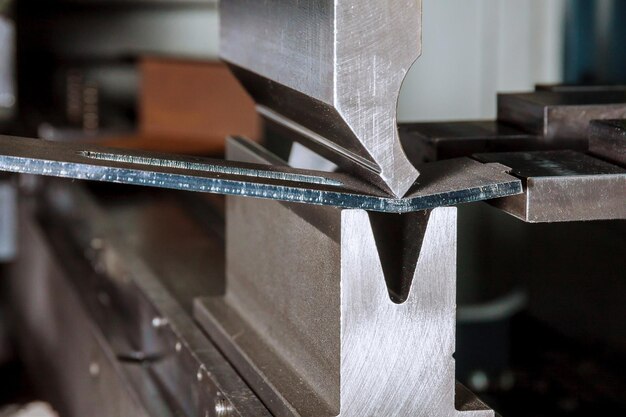
Metal bending and folding are the two integral metal forming operations. Due to the emerging technologies in the world of manufacturing, the transformation of metal sheets into 3D structures has gained immense popularity in the past few years.
Metal bending and sheet metal folding are achieved through techniques such as press braking, die bending, flanging, and edging. These techniques are used to form the metal into certain desired angular structures.
This blog explains metal sheet folding and bending, methods used for metal bending, and a step-by-step guide for metal bending. So, before you go through the necessary steps associated with metal bending, it is important to understand what sheet metal bending and metal folding are.
Metal Bending and Folding
Metal bending refers to the process employed in metal deformation. Metal sheet bending tool is equipped with panel blenders and press brakes. Sheet metal bending is a basic process to form metal stamping parts. It bends one shape of the metal sheet to create a product of a certain structure. An external force is applied through a hydraulic sheet bending machine to the metal to change its geometry and achieve the desired shape.
However, the process of metal sheet bending is not as easy as it seems. It involves various rules to be followed as there are certain dimensions involved. Some considerations are material check, K factor calculation, metal shape, etc. Furthermore, the malleability property of the metal also influences the metal bending process.
Metal folding involves positioning a metal sheet tightly. When the beam tool swings up and down as per the programmed direction around the pivotal point, the metal is folded into the desired shape. The dimension-related accuracy achieved by metal folding can be controlled using a sheet metal folding machine with greater precision. Also, metal folding machines use all-electric drives to develop designs that need lower maintenance and don’t change their forms due to various environmental factors. As a result, they offer high folding accuracy.
Common Methods Used for Metal Bending:
Well, all types of metal bending methods have a common goal, i.e., to bend a metal sheet into a specific shape. However, these methods work differently to ensure precision. Some of the primary methods used in metal bending are-
V- Bending:
V-bending is the most common type of metal bending process, which involves the utilization of a die and punch. The V-shaped punch presses the metal sheet into a V-shaped die, and this is how the V-bending of a metal sheet is obtained.
U- Bending:
U- bending is quite similar to V- bending. Like the shaped die and punch used in V-bending method, U -bending involves U- shaped die and punch and the result comes in a U- shaped metal bending.
Roll Bending:
This metal bending method involves bending the metal into a curved structure. This method involves 3 rollers, brakes, and a hydraulic pressing system. All three rollers are placed at a certain distance to bend a metal sheet in the curves.
Edge Bending:
Edge bending is one of the types of metal bending methods that help manufacturers bend the metal edges smoothly without causing any damage to them. It removes the sharpness of the metal corners and enhances the aesthetic appearance.
Rotary Bending:
Rotary bending is required when bending a metal sheet above 90 degrees is needed. It is similar to the v-bending method, but the only difference is the output, which is more aesthetic and uniform.
Step By Step Guide to Sheet Metal Bending and Folding
There are 4 steps involved in a successful metal bending-
Step 1:
Initial Design
It is the foremost step in performing metal bending. Certain factors need to be considered while planning an initial design for bending a metal sheet. These factors are bending deduction, flange length, bend relief notches, distance between the features and the deadline to avoid deformation and feature warping.
Step2:
Preparing Your File
Now, the second step is to prepare your file for bending. If you choose to upload a 2D file, you can use vector format export files such as DXF, EPS, DWG, or AI (Adobe Illustrator). while for 3D, upload your file in STP or STEP format and ensure that it meets the 3D file guidelines.
Step 3:
Metal Bending
Now, the next important process is metal bending. The metal bending machines are capable of forming any type of manufacturing parts. Although the tooling bend radius is changed as per the thickness of the material, you can check it by using a bending calculator.
Step 4:
Finishing Bent Metal Sheet
After bending, some markings can appear on the final product, but they are completely cosmetic and do not affect any machinery part. They can be removed using a DA orbital sander.
The Bottom Line
No doubt, metal bending, and folding have emerged as widely used and necessary manufacturing techniques used by manufacturing plants. From concept to the initial design and bending to finishing, the overall process of metal sheet folding requires thorough and deliberate design and top-notch manufacturing.
Metal bending and folding techniques can be used according to the materials and their thicknesses. AZ Metals provides a wide range of steel folding machines, requirements, and tools to the manufacturing plants in Mesa, AZ.
FAQs
1. What are the components of sheet metal bending machines?
The main components of sheet metal bending machines are panel benders and press brakes.
2. What is the most important property of any material that should be considered during metal bending and folding operations?
Malleability is the crucial property of any material that needs to be measured to avoid deformation and cracking in a sheet folding machine.
3. Which metal bending process is effective?
Every sheet metal process has its features and applications, it can be chosen based on the specific requirements.
4. What is metal laser cutting?
Metal laser cutting involves putting a highly contracted laser beam on the metal surface to create an accurate cut.
